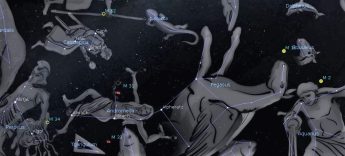This Week’s Sky at a Glance, 2024 Oct 26 – Nov 2
This Week’s Sky at a Glance, 2024 Oct 26 – Nov 2
Deep sky objects (DSOs), composed of star clusters and nebulae, are often called faint fuzzies by amateur astronomers but many are bright enough to be seen with binoculars in a dark sky. Let us start by using the Square of Pegasus as a guidepost. The southwest corner of the square is the base of the winged horse’s neck, and moving away from the square by a few stars takes us to the horse’s eye. Extending that line by half its distance is where you will find a small blurry patch called M2, a globular cluster that is the second entry in the Messier list of DSOs. Angling to the left at the eye we come to a star at the horse’s snout, and extending by nearly half that distance is a larger globular cluster, M15.
The star at the northeast corner of the square is Alpheratz, the brightest star of Andromeda, from which spread two lines of stars. The second star from Alpheratz along the brighter string is orange Mirach, and moving up two stars across the dimmer string we encounter the large Andromeda Galaxy, M31. In the opposite direction from Mirach, and at about the same distance as M31, is fainter M33, the third largest galaxy in our Local Group behind Andromeda and the Milky Way. We see M33 face on, which makes it appear dimmer.
The third brightest star of Andromeda is Almach, situated at the end of the string from Mirach. Look to the left of the line more than halfway between Almach and Algol, the second brightest star in Perseus, for the open cluster of stars called M34. Next, look above Andromeda for the familiar W-shape of Cassiopeia. A line from the bottom right star of the W to the top right and extended the same distance brings us to open cluster M52.
This Week in the Solar System
Saturday’s sunrise in Moncton is at 7:52 and sunset will occur at 6:13, giving 10 hours, 21 minutes of daylight (7:55 and 6:19 in Saint John). Next Saturday the Sun will rise at 8:02 and set at 6:02, giving 10 hours of daylight (8:05 and 6:09 in Saint John).
The Moon is near Regulus this Saturday morning and it is new next Friday. Mercury is low in the southwest this weekend, setting 30 minutes after sunset and extending that to 40 minutes by next weekend. Venus is ten degrees above the horizon at sunset all week, setting before 8 pm. Saturn is at its highest and best for observing around 10 pm, showing off its rings nearly edge-on. At that time on Wednesday telescope users might see Jupiter’s Red Spot near the middle of the planet. Seen best in the morning sky, late in the week Mars makes a prominent line with Castor and Pollux as it crosses the constellation border into Cancer. Comet C/2023 A3 Tsuchinshan-ATLAS should remain visible in binoculars as it moves between a pair of stars in the eastern shoulder of Ophiuchus on Monday, and near the end of the week it is within a V-shaped asterism that was once a constellation called Poniatowski’s Bull.
The Saint John Astronomy Club meets on November 2 at 7 pm in the Rockwood Park Interpretation Centre.

